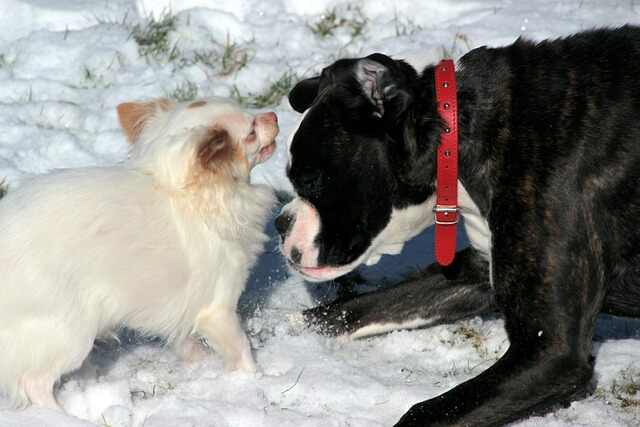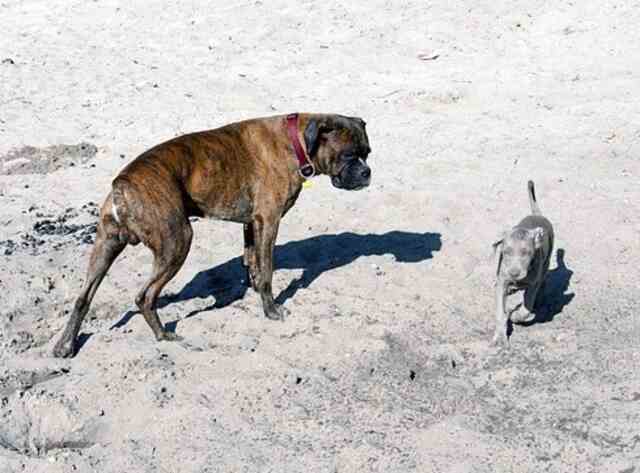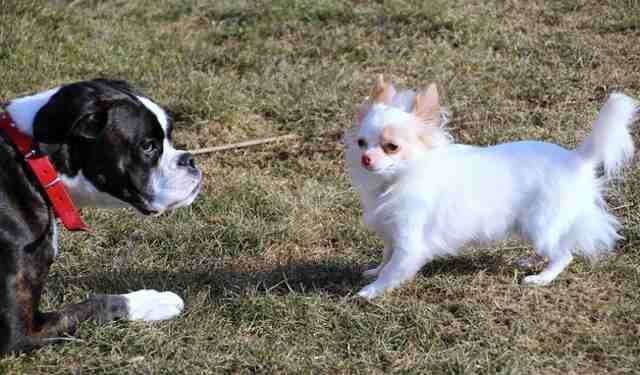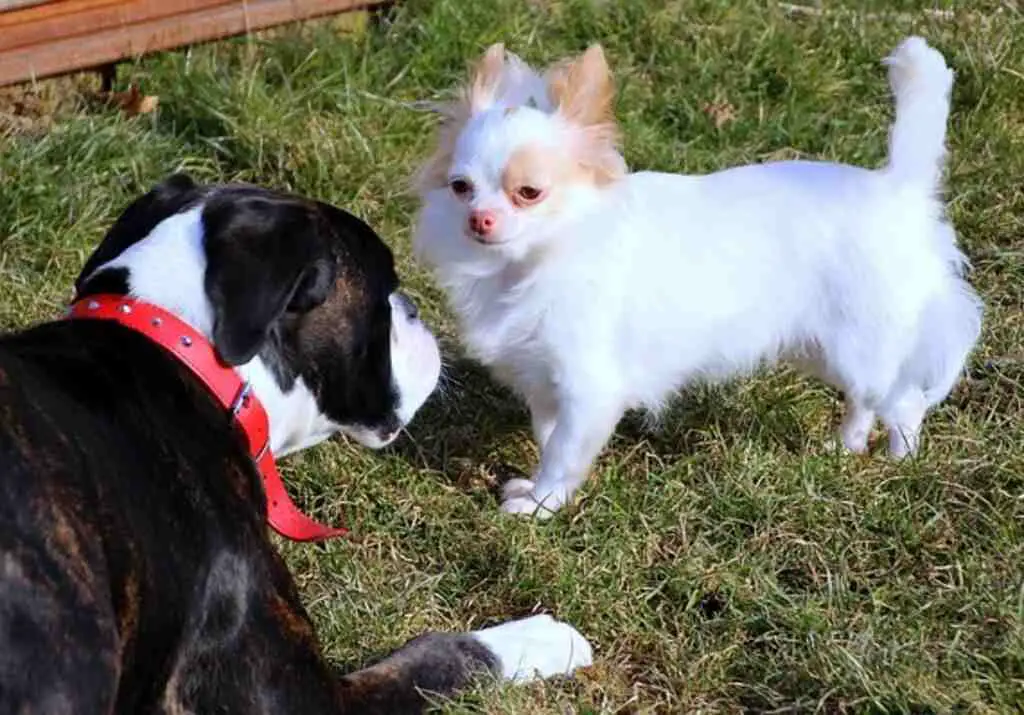Picture this: you’re at the dog park watching a 70-pound Boxer gently play-bow to a tiny Yorkie, then proceed to army crawl across the grass just to get closer without intimidating the little guy. Sounds too good to be true? Well, I’ve witnessed this exact scenario more times than I can count.
So, are Boxers good with small dogs? The short answer is yes, but success depends heavily on proper socialization, individual temperament, and your management skills. These bouncy, muscular goofballs have hearts as big as their bodies, but their enthusiasm can sometimes overwhelm smaller companions if you’re not careful.
Understanding the Boxer Temperament
The Gentle Clown Personality
Boxers earn their reputation as “clowns of the dog world” for good reason. These dogs combine playfulness with surprising gentleness, especially when they recognize size differences. I’ve watched adult Boxers instinctively adjust their play style when interacting with puppies or small breeds.
Their goofy nature actually works in their favor with small dogs. Boxers rarely display serious aggression and tend to approach interactions with curiosity rather than dominance. This playful mindset creates opportunities for positive relationships with smaller companions.
Energy Levels and Play Styles
High-energy Boxers need outlets for their enthusiasm, and this can either complement or clash with small dog personalities. Active small breeds like Jack Russell Terriers often match Boxers’ energy levels beautifully, creating dynamic play partnerships.
However, gentle small breeds might find Boxer energy overwhelming. The key lies in teaching your Boxer appropriate play boundaries and providing separate outlets for their most intense exercise needs.
Natural Pack Mentality
Boxers typically accept pack hierarchies easily, which works wonderfully in multi-dog households. They don’t feel the need to dominate smaller dogs and often defer to confident little personalities. I’ve seen 15-pound Corgis successfully boss around 80-pound Boxers without any issues.

Size Differences: Managing the Obvious Challenge
Physical Safety Considerations
Let’s address the elephant in the room – a 70-pound dog playing with a 10-pound dog requires careful supervision. Even the gentlest Boxer can accidentally injure a small dog during enthusiastic play. Size-related accidents happen more often than actual aggression incidents.
Watch for these potential hazards:
- Overly enthusiastic greetings that knock small dogs over
- Rough play that escalates beyond small dog comfort levels
- Resource guarding around high-value items
- Accidental stepping or bumping during excited moments
Creating Safe Interaction Spaces
Manage your environment to promote safe interactions. Baby gates allow small dogs to retreat when they need space, while elevated platforms give them escape routes from overly enthusiastic Boxers.
I always recommend multiple feeding stations and separate toy collections to prevent resource competition. Even the friendliest dogs can develop tensions over food or favorite toys.
Recognizing Size-Appropriate Play
Good Boxer-small dog play looks different from same-size play. Properly socialized Boxers naturally modify their play style, using gentler mouth contact, play-bowing more frequently, and allowing small dogs to “win” wrestling matches.
Socialization: The Make-or-Break Factor
Early Exposure Benefits
Boxer puppies who grow up with small dogs typically develop excellent size awareness. This early socialization creates lasting behavioral patterns that benefit the dog throughout their life. Adult Boxers without small dog experience need more careful introduction processes.
Ever wonder why some large dogs seem naturally gentle with small ones while others act clueless? Early socialization experiences literally shape their neural pathways for appropriate social behavior.
Adult Boxer Socialization
Adult Boxers can absolutely learn to coexist peacefully with small dogs, but the process requires patience and structured introductions. Don’t expect instant friendship – some pairs need weeks or months to develop comfortable relationships.
Successful adult socialization involves:
- Controlled, positive first meetings in neutral locations
- Gradual exposure increases over time
- Consistent reinforcement of gentle behavior
- Professional training support if needed
Reading Canine Body Language
Both breeds need to communicate clearly for successful relationships. Boxers express themselves through body language that small dogs must learn to interpret, while small dogs often use different signals that Boxers need to understand.
Watch for stress signals from small dogs: excessive panting, hiding, submissive urination, or aggressive posturing. These indicate the need to slow down the introduction process.
Breed-Specific Considerations for Small Dogs
High-Energy Small Breeds
Terriers, Beagles, and Cocker Spaniels often pair beautifully with Boxers because they share similar energy levels and play drives. These combinations create dynamic partnerships where both dogs benefit from shared activities and exercise.
I’ve seen Jack Russell-Boxer pairs that exhausted each other perfectly, then napped together afterward. Compatible energy levels solve many multi-dog household challenges.
Gentle Small Breeds
Cavalier King Charles Spaniels, Pugs, and similar calm breeds require more careful pairing with energetic Boxers. These dogs might appreciate a gentler companion, though some thrive with a playful protector.
Success depends on individual personalities more than breed generalizations. I know gentle small dogs who adore their Boxer companions and others who prefer calmer housemates.
Senior Small Dogs
Older small dogs need special consideration when living with young Boxers. Senior dogs often have less patience for puppy-like behavior and may need protected spaces where they can rest undisturbed.

Training Strategies for Multi-Dog Success
Teaching Gentle Interactions
“Gentle” commands work wonders with Boxers who naturally want to please their humans. Practice this command during calm moments, then reinforce it during small dog interactions.
Start training before problems develop. Teaching appropriate behavior is much easier than correcting established bad habits. Boxers respond beautifully to positive reinforcement training methods.
Managing Play Sessions
Structured play sessions prevent overstimulation and help both dogs learn appropriate boundaries. Set specific playtimes with clear beginnings and endings, using commands like “play time” and “all done.”
Interrupt play before it gets too intense rather than waiting for problems to develop. This proactive approach teaches both dogs that humans control interaction intensity.
Individual Training Time
Each dog needs separate training sessions to develop skills without competition or distraction. This individual attention also prevents jealousy issues that could strain their relationship.
FYI, group training classes can actually help multi-dog households by teaching both dogs to focus on humans even with other dogs present.
Common Challenges and Solutions
The Enthusiasm Problem
Overly enthusiastic greetings rank as the top challenge in Boxer-small dog relationships. Boxers express joy through full-body wiggles and bouncing that can overwhelm or injure small dogs.
Teach calm greetings by requiring sits before interactions and rewarding gentle approach behaviors. This training benefits all dog interactions, not just small dog relationships.
Resource Guarding Prevention
Multiple resource stations prevent competition over food, water, toys, and human attention. Even friendly dogs can develop resource guarding if they feel competition pressure.
Feed dogs separately and provide individual toy collections. This simple management strategy prevents most resource-related conflicts before they start.
Space Management
Small dogs need escape routes when living with larger companions. Baby gates, dog stairs to elevated surfaces, and designated small-dog-only areas provide necessary security.
Create calm zones where small dogs can retreat without Boxer access. These spaces reduce stress and give small dogs confidence to interact on their own terms.
Success Stories and Real-World Examples
My Friend’s Unlikely Pair
I’ll never forget visiting my friend Sarah’s house and meeting her Boxer, Tank, and her Chihuahua mix, Peanut. Tank would literally lie down whenever Peanut approached, creating an equal height dynamic for their interactions. The big guy had figured out that getting low made his tiny friend more comfortable 🙂
This self-modification behavior demonstrates the intelligence and adaptability that makes Boxers such great companions for small dogs when properly socialized.
The Foster Success Story
A local rescue regularly pairs Boxers with small dogs during fostering because Boxers often provide confidence boosts for nervous or undersocialized small breeds. The Boxer’s steady, friendly presence helps small dogs develop social skills.
These fostering successes translate to permanent home situations where Boxers serve as both companions and confidence builders for their small housemates.
Age Considerations
Boxer Puppies with Small Dogs
Boxer puppies require extra supervision around small dogs because puppies lack impulse control and size awareness. However, puppies also adapt most easily to living with small companions.
Puppy energy levels can overwhelm even energetic small dogs. Provide plenty of individual exercise for your Boxer puppy to prevent them from using small dogs as entertainment.
Adult Boxers and Small Puppies
Adult Boxers often excel as “nanny dogs” for small puppies, showing remarkable gentleness and protective instincts. Many Boxers naturally adjust their behavior around babies of any species.
Supervise interactions carefully but don’t be surprised if your Boxer takes on protective responsibilities for small puppies in the household.
Senior Considerations
Older Boxers typically mellow considerably, making them excellent companions for small dogs who might have found younger Boxers too energetic. Senior-to-senior pairings often work particularly well.

Health and Safety Protocols
Regular Health Monitoring
Both breeds need regular veterinary care, but size differences create different health considerations. Small dogs face different risks (tracheal collapse, luxating patella) than Boxers (heart conditions, bloat).
Monitor both dogs for signs of stress or illness that could affect their relationship. Sick or painful dogs often become less tolerant of housemates.
Emergency Preparedness
Know your emergency protocols for size-related accidents. Having a plan reduces panic and ensures quick, appropriate responses if injuries occur.
Pet insurance considerations differ for large and small breeds. Research coverage options that make sense for your specific combination of dogs.
Long-Term Relationship Management
Maintaining Harmony
Successful multi-dog households require ongoing management, not just initial introductions. Relationships evolve over time as dogs age, experience changes, or face health challenges.
Regular assessment of their relationship helps you identify and address small issues before they become major problems. Pay attention to changes in interaction patterns or stress levels.
Adapting to Life Changes
Moving, new family members, or schedule changes can affect dog relationships. Boxers and small dogs may react differently to these stressors, requiring individual support strategies.
Maintain routines that support both dogs during transitions. Consistency helps both breeds feel secure during uncertain times.
The Bottom Line
Boxers can absolutely thrive with small dog companions when you provide proper socialization, ongoing training, and thoughtful management. Their naturally gentle temperament and desire to please make them surprisingly adaptable to multi-dog households.
Success requires commitment to understanding both dogs’ needs and creating environments where both can flourish. The size difference that seems like an obstacle often becomes the foundation for beautiful, protective relationships.
IMO, there’s something incredibly heartwarming about watching a gentle giant carefully navigate around their tiny best friend. These relationships challenge assumptions about dog compatibility and prove that love truly comes in all sizes.
Take the time to do introductions properly, invest in good training, and don’t rush the process. Your patience will be rewarded with a household dynamic that brings daily joy and demonstrates the amazing adaptability of our canine companions :/
Related Post: 10 Hardest Small Dog Breeds To Train (Solved & Explained)


